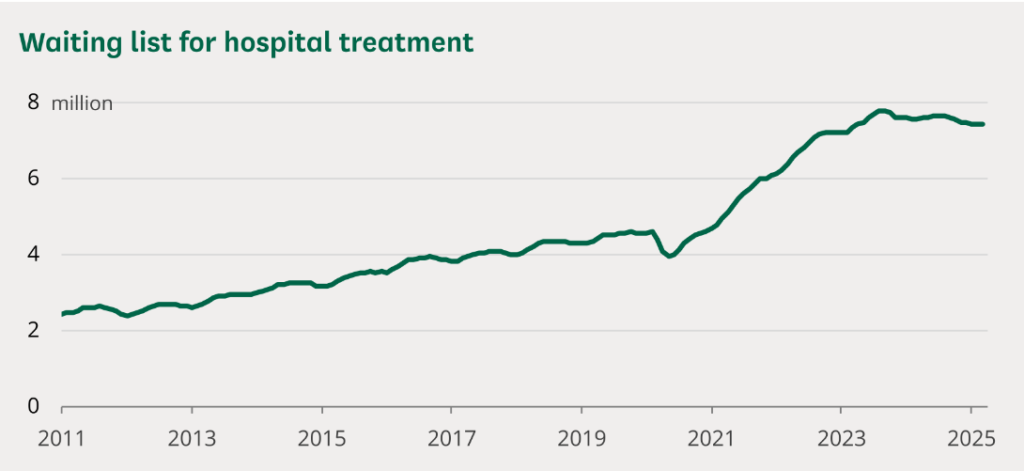The latest monthly performance data from NHS England offers a welcome and encouraging snapshot of a health service making significant strides under immense pressure. The figures, covering April and May 2025, reveal positive developments across elective care, diagnostics, and emergency services, suggesting that focused efforts to improve efficiency and patient flow are yielding tangible results.
Let’s delve into the key numbers and explore what they mean for the future of healthcare delivery in the UK
A Turning Tide for Elective Care Waiting Lists

Source: NHS key statistics: England, May 2025
This progress is underpinned by a significant increase in activity. The NHS delivered 1.45 million elective treatments in April, a 3% rise compared to the previous year. Furthermore, the median waiting time for patients needing planned treatment fell to 13.3 weeks, the lowest since July 2022. Achieving this level of throughput is a monumental task that hinges on exceptional operational management. Streamlining the entire patient journey, from referral to treatment, is critical to tackling the backlog, highlighting the value of systems that can optimise patient flow and manage capacity effectively
The data also reveals an all-time high for diagnostic activity. In April, a record 2.4 million tests, checks, and scans were delivered. This figure is a full 25% higher than pre-pandemic levels in April 2019, with community diagnostic centres playing a vital role in this expansion.
The data also reveals an all-time high for diagnostic activity. In April, a record 2.4 million tests, checks, and scans were delivered. This figure is a full 25% higher than pre-pandemic levels in April 2019, with community diagnostic centres playing a vital role in this expansion.
Diagnostic Tests Delivered: 2.4 Million tests, checks, and scans were performed in April 2025, a 25% increase compared to pre-pandemic levels.
Handling this unprecedented volume requires more than just new facilities; it demands intelligent scheduling and seamless patient flow to ensure that diagnostic services can meet demand without creating new delays
Meeting the Challenge in Urgent and Emergency Care
Emergency departments continue to face extraordinary demand. May 2025 was the second busiest month on record for A&E in England, with attendances approximately 10% higher than pre-pandemic levels.
Despite this surge, performance has improved significantly. The number of patients admitted, transferred, or discharged from A&E within four hours reached a six-year high in May. This is a powerful testament to the impact of modern operational strategies. In high-pressure environments like A&E, tools such as virtual queuing and intelligent patient triage are transformative. They help manage patient influx, reduce dangerous overcrowding in waiting rooms, and free up staff to focus on clinical priorities—directly contributing to better performance metrics even during the busiest periods.
Positive Momentum in Other Critical Services
The positive trends extend to other vital areas. April saw a record number of urgent suspected cancer referrals, with over 270,000 people checked by a specialist, and an increase in patients starting treatment compared to the previous year
Ambulance Response Times Improve : The average response time for Category 2 incidents (e.g., suspected strokes) was the fastest it has been in two years during May 2025.
The Path Forward is Paved with Efficiency
The latest NHS data is a story of resilience and progress. It demonstrates what can be achieved when the health service successfully boosts activity and enhances efficiency. However, with demand remaining at an all-time high, this momentum can only be sustained by fully embracing the digital tools that optimise every step of the patient journey. Intelligent solutions that manage patient flow, eliminate bottlenecks, and empower staff with real-time data are no longer just an advantage, they are essential. By embedding this technology at the heart of our healthcare system, we can build on these recent successes and create a more resilient, responsive, and efficient NHS for the future.
At QHERE, we believe that when it comes to healthcare, time matters – and it must be made to count. That’s why our platform brings together scheduling, patient flow management, and real-time capacity insights onto one intelligent system.
With QHERE, clinics can:
- Seamlessly balance NHS, self-pay, and insured patient loads
- Reduce appointment bottlenecks
- Maximise consultant and facility utilisation
- Free up admin staff to focus on delivering patient-centred service
Whether you’re a growing diagnostics hub, an established private hospital, or an NHS-affiliated provider, QHERE helps you unlock your true capacity potential.
Learn more or start your free trial today to experience a smarter way of managing your operations.


